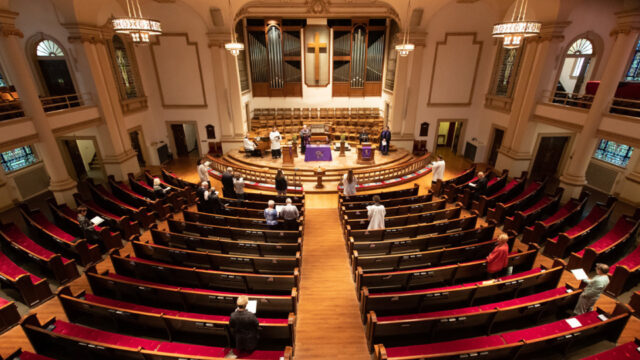Of Polls, Religious Revival, and the Zoomer Myth

One of the most dangerous things a right-wing writer can do is to cite a poll. The audience will often flip out at the mere sight of a survey reference. I regularly get hysteric responses whenever I write an article based on this data. Some right-wingers wail and gnash their teeth at this grave offense, demanding you never rely on polling again. They insist you rely solely on vibes and unverified anecdotes to back up your claims.
This anti-scientific method is used to buttress a variety of claims, such as that Zoomers are extremely BASED and that America is experiencing a religious revival. However, there is one polling firm that aims to prove the latter claim as true, providing some of the few surveys right-wingers will unapologetically promote.
The Barna Group, an evangelical polling firm, released multiple surveys this year apparently proving a religious revival is underway. In an April poll, Barna claims 66 percent of Americans have made a personal commitment to Jesus Christ and it’s an important part of their lives. In a September poll, Barna reportedly found that Zoomers are more likely to attend church than Boomers. In an October poll, the firm alleged more men attend church weekly than women (43 percent of all American men versus 36 percent of all American women).
These are incredible figures and are widely cited by conservatives. The problem is that literally every single other poll shows an entirely different picture. These polls even go against common experience. Most churches one will go to are heavily skewed towards older people and women being in the pews. Barna’s polling is like Ann Selzer’s infamous Iowa poll that showed Kamala Harris winning the state while every other survey found Trump winning the state easily. The other polls proved correct.
While Barna claims 66 percent of Americans are deeply committed to the Christian faith, more reliable polling puts the number of self-professed Christians at roughly 62 percent. This was greeted earlier this year as good news by the faithful as it showed no further decline in Christian affiliation from previous surveys. The trend over the past 30 years has been a steady drop in Americans proclaiming themselves Christians. The latest figure showed it holding steady.
It must be remembered that the 62 percent includes many who don’t think religion is that important to their life. Gallup released a new poll demonstrating a massive drop in the number of Americans who say religion animates their existence. Just 49 percent of Americans say religion is important to their daily lives, which marks a 17 percent drop from 2015. This figure includes non-Christians as well. It’s unlikely Barna’s figure of 66 percent is accurate when only 62 percent of Americans say they’re Christian and a sizable number of them don’t place much importance on their faith.
There is data showing some interesting religious developments among Zoomers, such as that the men of the generation, in contrast to past generations, are now more likely to be Christian than the women. But there’s still a steep decline in faith among the young. Pew’s latest research shows only 45 percent of Americans under 30 identify as Christian. In contrast, 78 percent of Americans over 65 claim to be Christian. That makes it hard to believe Barna’s claim that Zoomers are more likely to attend church than their elders.
Most data indicates that women outnumber men in the pews. More women (66 percent) identify as Christians than men (59 percent). Young men now attend church more than young women, but that doesn’t mean that it’s the same for all generations. What’s most off-base about this Barna poll is how many Americans it shows attending church weekly. The poll indicates roughly 40 percent go weekly. But other polling shows 20 to 24 percent of Americans attend religious services–which includes non-Christian services–weekly. With only 62 percent of Americans identifying as Christian and fewer saying it’s important to their daily lives, it doesn’t seem Barna’s figure of 40 percent or so Americans attending church weekly seems accurate.
If it was true, we would not see an estimated 15,000 churches close their doors this year. It should also be noted that there is a growing trend of self-professed evangelicals who don’t regularly go to church. (This demographic provides Donald Trump’s strongest base of support.)
America’s current religious picture is complex. Zoomers may end up scrambling predictions of what our nation’s religious life will look like. But one thing is clear: we are a much more secular country than we were 20 years ago. It’s an uncomfortable picture for many conservatives, which is why Barna’s polling proves so popular on the Right. Conservatives want to believe the tide is being reversed and America will soon return to its past faithfulness. Surveys paint a different picture.
Polling in the near future may demonstrate noticeable gains in Christian adherence. However, as of right now, Barna’s popular surveys show a picture wildly out-of-sync with reality.
Not all polls are equal. One must look at other data to find the most accurate picture. When the data looks too good to be true, such as remarkably high black support for Trump (a common feature of conservative political polling), skepticism is warranted. This is the case with Barna.
We may yet see a religious revival among Zoomers, but one shouldn’t look to the evangelical firm’s polling for proof. It seems more wishful thinking than accurate data gathering.
https://www.highly-respected.com/p/of-polls-religious-revival-and-the
